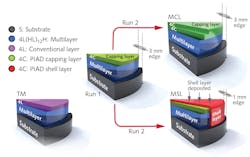Deposited shell improves stability of e-beam optical coatings
Electron-beam (e-beam) deposited optical coatings are widely used in optics for high-power laser systems due to these coatings’ relatively high laser resistance, good spectral uniformity, and the ability to scale to large apertures. Unfortunately, the porous nature of e-beam coatings makes them susceptible to absorption and desorption of water and therefore to environmental humidity—a problem that is especially apparent when a coating is moved from, say, the humid outdoors to an air-conditioned lab, or to vacuum. In addition, e-beam coatings are susceptible to age-related degradation due to changing stresses in the coatings. As a result, a method to fabricate low-stress e-beam coatings with long-term stability is needed.
A group from the Shanghai Institute of Optics and Fine Mechanics (Shanghai, China), University of Chinese Academy of Sciences (Beijing and Hangzhou, China), CREOL, The College of Optics and Photonics, University of Central Florida (Orlando, FL), and the CAS Center for Excellence in Ultra-intense Laser Science (Shanghai, China) has proposed a shell-layer fabrication approach to achieve a low-stress e-beam coating with significantly improved long-term stability.1
Shell keeps out humidity
In this work, the researchers cover the top surface and sidewall of the e-beam coating with a shell layer deposited via plasma ion-assisted deposition (PIAD). The researchers say that the shell layer can effectively isolate the inner e-beam coating from the ambient humidity, significantly improving the long-term stability and mechanical properties of the e-beam coating. In addition, isolating the coating from ambient humidity this way avoids the increase in compressive stress caused by water absorption of the e-beam coating, maintaining the coating stress at a low level.
In an experiment, a PIAD monolayer, two bilayer coatings, and three multilayer coatings were deposited on various substrates using an evaporation coater with a plasma-assist system (see figure). The three multilayer coatings included a traditional multilayer (TM), a multilayer with a capping layer (MCL), and a multilayer with a shell layer (MSL). The researchers used BK7 crown glass, ZF7 lead glass, and barium fluoride (BaF2) as substrates to test for stress, UV/VIS/NIR spectral performance, and Fourier-transform infrared (FTIR) spectroscopic characterization, respectively. The shell layer overlaying the MSL coating covered both the top surface and sidewalls of the underlying porous e-beam-fabricated layer stack, totally isolating the multilayer coating from the surrounding air.
First, the researchers verified that the PIAD silicon dioxide (SiO2) layer remained moisture-proof after aging by performing x-ray photoelectron spectroscopy on a sample that was aged for three years; the analysis showed that the layer remained water-free. Next, UV/VIS/NIR spectral uniformity was measured at numerous points on the various coatings. With no overcoat, the TM coating almost at once showed a large water-absorption peak in the 2700–3800 cm-1 spectral range, indicating rapid water absorption. The researchers fabricated multilayer films that were capped only on top with the SiO2 layer, with the side walls exposed. These structures showed slow absorption over a period of 170 days, indicating that water worked its way in from the sidewalls—meaning that true water resistance arises only when the sidewall are also capped.
The next test was more intense: both uncapped (TM) and totally capped (MSL) coatings were immersed in water for 24 hours; the TM coating suffered severe corrosion and the appearance of blisters, while the MSL coating protected the underlying layers from water, although there was some separation of the SiO2 layer from the underlying e-beam-deposited layers.
Scratch tests were also performed with a diamond stylus pressing with a constant normal force load of 0.5, 1.0, or 3.0 mN at a 30 μm/s speed. The TM coating scratched under both the 1.0 and 3.0 mN forces, while the MSL coating only scratched under the 3.0 mN force, and with a reduced groove depth.
The researchers say that the shell-layer approach allows the stress of the e-beam coating to be evaluated without water in an atmospheric environment, rather than the traditional evaluation achieved by performing wavefront measurements in a vacuum environment. Thus, it is easier to address time- and environment-dependent instability of coatings for high-power laser applications.
REFERENCE
1. T. Zeng et al., Opt. Mater. Express (2020); https://doi.org/10.1364/ome.405283.
About the Author
John Wallace
Senior Technical Editor (1998-2022)
John Wallace was with Laser Focus World for nearly 25 years, retiring in late June 2022. He obtained a bachelor's degree in mechanical engineering and physics at Rutgers University and a master's in optical engineering at the University of Rochester. Before becoming an editor, John worked as an engineer at RCA, Exxon, Eastman Kodak, and GCA Corporation.

